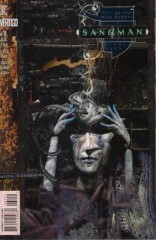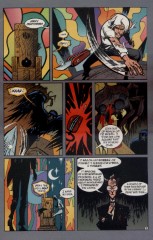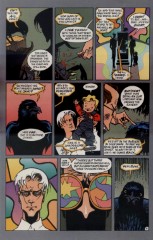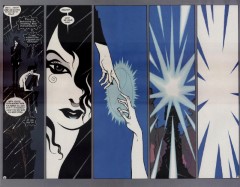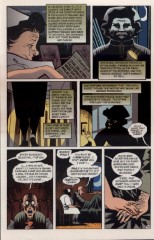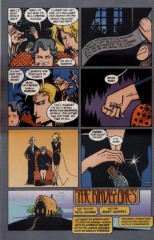Issue 69: "The Kindly Ones: 13"
Neil Gaiman, Marc Hempel
- Thirteenth part of storyline, The Kindly Ones
- Fourteenth story reprinted in trade paperback The Kindly Ones
Page 1#
Panel 5
See 8:9.5, if you don't remember.
Page 3#
Panel 7
Nybbas as found in the online Brewster's The Dictionary of Phrase and Fable:
Devil's Cabinet (The). Belphego, the Devil's ambassador in France; Hutgin, in Italy; Belial, in Turkey; Tharung, in Spain; and Martinet, in Switzerland. His grand almoner is Dagon; chief of the eunuchs is Succor Benoth; banker is Asmodeus; theatrical manager is Kobal; master of ceremonies, Verdelet; court fool is Nybbas. (Victor Hugo: "Toilers of the Sea")
I don't know that Hugo's work, but I guess the original reference could be much older...
Page 4#
Panel 8
Lucien is quoting John Webster again: The White Devil Act IV scene 3.
Page 5#
Panel 3
Death may possibly be referring to Dream's captivity; more likely this is some hitherto-undisclosed incident in Dream's history.
Page 7#
Panel 1
Note the panel border. A black border seems to refer to the raw, root underpinnings of dreams and the Dreaming.
Page 8#
Panel 2
In Norse myth, Loki's writhings were the cause of earthquakes. This comes at the same time as the dreamquake.
Pages 10-11#
Panel 3
The positions of the hands is reminiscent of those of God and Adam in Michelangelo's "Creation of Adam".
Page 13#
Panel 1
As Titania remonstrates with Nuala, note the Puck, who had also spoken of leaving Faerie, chained at her feet. Note also that this vignette and the ones in the next few pages contain echoes of the event immediately past: a man and a woman taking each other's hand; leaving one place or plane in favor of an uncertain destination; references to death (including punning use of the word "late").
Page 14#
Panel 7
If we assume that Delirium went looking for Barnabas only a day or two after he lost her, this confirms that each issue of "The Kindly Ones" represents about a day.
Page 15#
Panel 4
Never ask that question.
Panel 5
This is an image from the fairytale best known today as "Diamonds and Toads" (or "The Fairy"), from Perrault's classic 17th-century French collection. The mistreated but virtuous younger sister meets a fairy by a spring and politely gives her a drink; she is rewarded by having flowers and treasure fall from her mouth whenever she speaks. The favored but selfish older sister tries to imitate her, but is rude to the fairy and has snakes come out of her mouth. Folklorists have recorded many variants of this story, classified as "The Tale of the Kind and the Unkind Girls," Aarne-Thompson Type 480; the Grimms' collection has a similar version, called "Mother Holle."
Page 16#
Panel 2
Lucifer echoes Loki's words to Carla in 60:24.2. Mazikeen's line: "How what comes out?"
Panel 6
Aye, there's the rub: Lucifer is making a reference to the famous soliloquy from Hamlet, act III scene 1.
"...To die, to sleep;
To sleep: perchance to dream: ay, there's the rub;
For in that sleep of death what dreams may come
When we have shuffled off this mortal coil,
Must give us pause:"Mazikeen's lines:
"Where are you going this time?" "I will follow you for ever...I must."
Page 17#
Panel 5
Some people have speculated that the donor was Rosemary, the woman shot by Doctor Dee in issue #5. The timing would seem a bit odd, though, since that would mean that issues 2-4 took seven months to happen.
Page 18#
Panel 6
Hal says, "In the midst of death, we are in life". I don't know if this was noted and simply not annotated because it was so obvious, but I figured I'd mention anyway that it's a reversal of a line that my quotation dictionary lists as coming from "Burial of the Dead" in Book of Common Prayer: "In the midst of life we are in death." (found by Sarah Alderdice viverais@freeze.com)
Page 19#
Panel 1
There has also been speculation that the solicitor (British dialect for "lawyer") was Rose's love, Jack Holdaway. Or it could be just another random death echo.
Panel 2
This echoes Edwin Paine's personal hell from "The Season of Mists" part 4 (25:8).
Panel 3
Banshees: female ghosts that wail for the dead. Some sources have it that those who hear them will die soon, too. Harpies: monsters from Greek myth, with bodies like eagles, women's heads, and snakes for hair.
(Does anyone at this point really need me to define "furies"?)
Page 20#
Panel 2
The title of Larissa's book parodies a mid-'80s bestseller, When Bad Things Happen to Good People, by Rabbi Harold Kushner.
Panel 5
"Red Zinger" is, if not a real flavor of commercially available herbal tea, certainly the sort of name that herbal tea gets.
Panel 8
Well, nice of her to give Lyta a head start, at least.
Page 22#
Panel 4
This panel echoes the one we saw in Destiny's book in "Brief Lives" part 7 (47:14.3). Gaiman has said that it is intentionally not precisely the same, which leads to the interesting speculation that the Destiny who survived the reality storm is not the same one that we had seen so many times previously.
Panel 5
There seem to be reversals here: the new Dream has white hair and clothes instead of black; his jewel is green (the complementary color to a ruby's red); the least of the dreamstones has taken the role previously filled by the greatest.
Page 23#
Panel 1
This panel, beginning the epilogue to "The Kindly Ones" echoes another from the prologue to it: 57:2.2.
It also concludes the meta-narrative on the story that runs through most of the starting panels:
57:1.1:
Is it ready yet? Are you Done?
Nearly. There we go.58:1.1:
Well? How long is it going to take?
59:1.1:
I think it's going to be bigger than I had planned.
I don't mind. As big as it needs to be.60:1.1:
I wish I could be certain that I was doing the right thing.
61:1.1:
It's happening. Very slowly, but it's happening.
It always takes longer than you think, doesn't it?63:1.1
I never thought I would ever get to this place.
Destinations are often a surprise to the destined.64:1.1
(thread about to be cut)
65:1.1
Almost time.
Nearly. Very nearly.66:1.1
(thread pulled apart)
There.67:
... (there's no text in this first panel)
68:1.1
Still here, then?
69:23.1:
So it's finished.
Yes.
Panel 2
Gaiman seems to be punning on the slang use of "yarn" to mean "story".
Panel 3
A double echo. Clotho's dialogue echoes 6:4.1: "She's realized the real problem with stories -- if you keep them going long enough, they always end in death." The panel itself echoes 57:2.1. Except that there the cat was playing with the yarn, not a mouse it had caught and killed.
Panel 4
Echoes 57:1.3.
Panel 5
Echoes 57:3.4.
Panel 6
The Gracchae were a trio of women in Greek mythology who had only one eye between them. (It was detachable and they passed it around.) The hero Perseus stole their eye and demanded information about the Gorgons as ransom for its return. The remark also perhaps echoes 63:20.7: "Are you a hand? Or an eye? Or a tooth?"
Page 24#
Panel 6
As is the theme, this panel returns to the start, echoing 57:1.1.
Panel 7
Interesting to note that the two issues which Hempel inked are the first and the last.
While we're talking about Sandman here, there was a question at the end of The Kindly Ones. Neil mentioned it himself, in the Writer's Comments section he usually includes for the trade p/backs. "Who was Loki & Puck working for?"
Personally, I think it might have been Dream, himself. At the end of A Season of Mists, he tells Loki that he owes him a favour. I think Dream asked Loki to either a) bring Daniel to the Dreaming, or b) do a) and burn away his immortality as well.
Then, if it's a), Loki decides to chuck Daniel in the fire, to double-cross Dream. (It's his nature, after all.) So Dream asks the Corinthian to get Daniel, 'cos Loki isn't going to bring him back.
If it's b), then the Eye Guy is Dream's failsafe plan, in the case Loki decides not to bring him back.
Not sure where Puck fits into all this. Maybe Dream asked him to fetch Daniel as well? Or maybe Loki asked him to help, after Dream told him what to do. Anyway, it fits. What do you think?
Credits
- Greg "elmo" Morrow (morrow@physics.rice.edu) created the Sandman Annotations.
- Originally collated and edited by David Goldfarb.
- Katie Schwarz (katie@physics.berkeley.edu) provided the information about the fairy tale and noted various echoes on the last two pages.
- Joe Brenner (doom@kzsu.Stanford.EDU) pointed out the White Devil quote.
- Timothy Hock Seng Tan 083285@bud.cc.swin.edu.au who knew who Loki & Puck are working for.
- Sarah Alderdice viverais@freeze.com added a note about p18.
- Ralf Hildebrandt added more details.
- Richard Munn noted the first panel meta-commentary, and the continued theme of start-end panels on arcs.
Last modified by Richard Munn on 2023-08-21 - Built another new plugin to better handle newlines in blockquotes, and removed manually inserted breaks
[edit this page] [page history]
